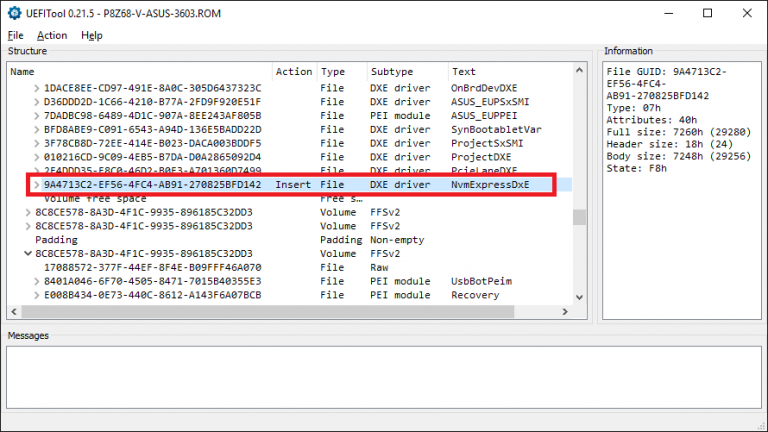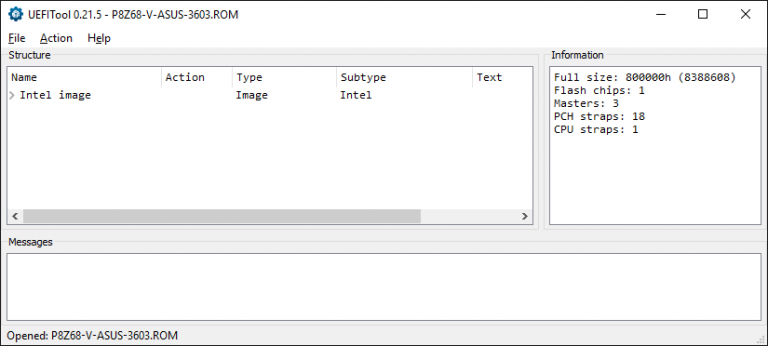

- #NVMEBIOS UEFITOOL INSTALL#
- #NVMEBIOS UEFITOOL WINDOWS 10#
- #NVMEBIOS UEFITOOL PRO#
- #NVMEBIOS UEFITOOL PLUS#
I pulled the three Nvme modules off a ASUS Z97 Bios if that is relevant.
#NVMEBIOS UEFITOOL PLUS#
I've spent a lot of time reading all the Guides and Tutorials and have added the three NVMe modules to the Bios plus the NvmExpressDxe_4 module. The 970EVO is installed in a PCIe Gen3x16 slot using a M.2 adapter.
#NVMEBIOS UEFITOOL PRO#
I'm running Win10 Pro on an ASUS P8Z77-V-LX motherboard with a Ivybridge Core i7 processor and I would like to be able to put the OS on to a Samsung 970EVO Plus SSD and boot from there. Hi Guys, I know I'm coming a bit late to this party but I hope maybe someone can help.
#NVMEBIOS UEFITOOL WINDOWS 10#
I was able to do this step first, as the Win10 installer locates the drive without issue, it's just the bios that can't boot from there, so for me after step 9, my drive booted and the Windows 10 installation continued without issue!

#NVMEBIOS UEFITOOL INSTALL#
If you do not see it, use the boot stick from step 2 to install Windows 10 on the M.2 drive. Reboot the computer and you should see your M.2 drive as bootable (if you already installed Windows on it). Replace the USB drive on the target computer from step 7, and run the command to flash the new bios (i.e. You may leave that computer on, but move the USB drive to another computer to run MMTool.įollow the guide under the "MMTool " section to insert the ffs file into your file (creating a "" file) cd /D C:\tmp) You might need to use diskpart.exe to figure out which drive-letter is your USB stick.Įxtract your current UEFI BIOS to a file (i.e. Extract all the files if they are compressed archives (zip/rar/7z/etc).īoot using the USB drive from step 2, select Troubleshooting and then Command Line.Ĭd into the folder created in step 3 (i.e. Use the Windows 10 Media Creation Tool to create a Win10 boot USB stick.Ĭopy the 3 files from step 1 into a new folder on the USB drive from step 2. I was able to flash either of daltonpearson's files from above, but it did not allow booting from the M.2 drive for me, even though under my uneducated-inspection it looked good.ĭownload AFUWIN64_v3.05.04, MMTool Aptio, and NvmExpressDxe_4.ffs (links found in this Guide). I was unable to flash a modified 1402 bios from ASUS, but I was able to flash a modified 1402 bios which I obtained by extracting it from my bios. Perhaps this is CAP vs ROM format, I am not sure, but this was the key to why I had problems yesterday. I am not sure why, but worth noting - I can flash the latest 1402 bios from ASUS, then immediately extract it and the file is about 2KB smaller. For me, I did not have a working OS on the computer and so some of the steps below can be skipped/modified if you do. While I'm still not sure why my previous attempts didn't work, I'll describe what worked for me for posterity. Update: I managed to get my Asus P8Z77-V-LK booting to Windows 10 on a PCIx 4x slot, with an M.2 NVMe drive in an adapter card. Can you provide any more details on how you got yours to work? What did you use to flash the files, and how did you make the modified ROM (they both look different from my source file, the 1402 bios). Bios still won't recognize my NVMe drive as bootable though. I have been unable to get my own files to write (using AFUWIN64_v3.05.04, size mismatch) to my P8Z77-V-LK, but I was able to write your Modified.rom file. It wouldn't show up until I did a fresh install of windows and I had to disable CSM, but then it started working flawlessly. I can confirm that this works with the P8Z77-V-LK motherboard from Asus, just got it working with an Intel 660p nvme drive. (Z77 will be EFI with compatibility support module Disabled, and legacy mode with it Enabled - so make sure you disable CSM before installing, itll also improve your boot times) Remember the drive most likely won't appear in the boot menu (though it did for me AFTER installing the OS), and also remember the install from the M5 board might not be bootable on Z77 board anyway due to differences with drivers, it's best to do a complete clean install when changing entire platforms, it'll also make sure you are running in EFI mode rather than legacy mode.

When i was using the Q77 board, i was running the NVMe drive on the 2.0 x4 slot, which limited the speed of my 950 Pro down to 1.2-1.6GB/s, so what your seeing of 1.2GB is normal for 2.0 x4. The method i used in the OP works 100% with Z77 boards, it worked perfect on both my P8Z77-V-PRO as well as my P8Q77-M board.


 0 kommentar(er)
0 kommentar(er)
